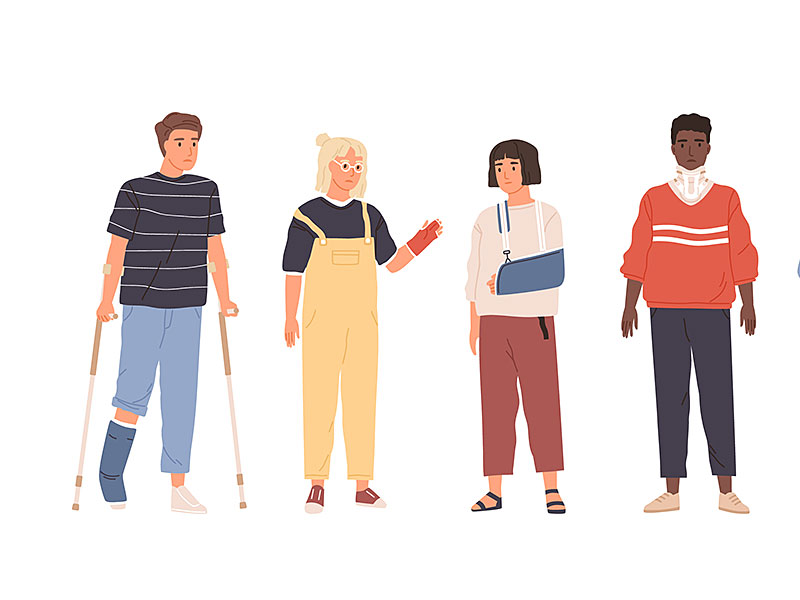Don't let an injury ruin your holiday fun. These tips can help keep you injury-free.
 The winter holidays can be a wonderful time of year, but with all of the hustle and bustle that goes along with the season, they can also be a time when you're more likely to get hurt. No one wants to be sidelined with an injury during the holidays, or at any time for that matter. That's why knowing what injuries you may be more at risk for, and taking precautions so you're less likely to get hurt, can go a long way in helping you stay injury-free so you can fully enjoy the joys of the season.
The winter holidays can be a wonderful time of year, but with all of the hustle and bustle that goes along with the season, they can also be a time when you're more likely to get hurt. No one wants to be sidelined with an injury during the holidays, or at any time for that matter. That's why knowing what injuries you may be more at risk for, and taking precautions so you're less likely to get hurt, can go a long way in helping you stay injury-free so you can fully enjoy the joys of the season.
Common Orthopedic Injuries
These are some of the most common orthopedic injuries that occur during the winter holidays:
- Sprains and strains. These are injuries to ligaments and tendons, respectively. They occur when you twist or overstretch a joint and can be minor or severe.
- Fractures. Falls can lead to fractures of the hip, knee, ankle, wrist and other bones.
- Dislocations. This occurs when a bone is forced out of its normal position in a joint. It can be a very painful injury and usually occurs due to a fall or trauma to the body.
- Overuse injuries. Injuries may be caused by repetitive use of muscles or joints, without giving them enough time to rest and recover.
Reasons Injury Risk Increases During the Holidays
Here are a few reasons why more people experience orthopedic injuries at this time of year:
- Holiday decorating. Hanging lights, putting up the Christmas tree and decorating your home can involve climbing ladders and may put you in precarious positions that increase your fall risk. Approximately 160 decorating-related injuries occur each day in the U.S., according to the Consumer Product Safety Commission.
- Repetitive activities. Carrying heavy shopping bags, shoveling snow and performing other activities that you do over and over again can strain your muscles and joints, leading to overuse injuries.
- Athletic activities. Many people participate in winter sports, such as skiing, snowboarding, skating and sledding, during the holidays. These activities can be a lot of fun, but they also carry a risk of injury. Even a friendly game of touch football can make it more likely you'll get hurt.
- Environmental conditions. Depending on where you live, ice and snow increase your risk of slipping, especially if you're not wearing proper footwear.
How to Prevent Winter Orthopedic Injuries
There are a number of things you can do to prevent injuries at this time of year, including:
- Use caution when decorating. Be careful when climbing ladders and using other tools and equipment. Don't lift heavy objects, reach too far or twist your body in awkward positions.
- Warm up first. You're less likely to get injured if you warm up your muscles and joints before participating in sports or performing other physical activities.
- Take breaks. Activities like shoveling snow or hanging lights can be hard work, so take breaks every 15-20 minutes to rest and stretch.
- Wear proper footwear. Make sure you wear shoes or boots with good traction when you're walking on icy or snowy surfaces.
- Be aware of your surroundings. Watch out for hazards when walking or driving, even if you have a lot on your mind. Being distracted increases your risk of getting hurt.
- Take your time. Don't rush to get things done. It's better to be safe than sorry.
- Ask for help. Don't be afraid to ask a friend or family member for assistance. Many injuries can be avoided if you have an extra hand or two to help.
- Listen to your body. If you're feeling pain, stop the activity and rest. If you suspect you have an orthopedic injury, see a doctor.
If you experience an orthopedic injury, don't ignore it. Diagnosing the injury and treating it can help minimize damage and speed up your recovery so you can continue to enjoy some holiday fun.
Copyright 2023 © Baldwin Publishing, Inc. Health eCooks® is a registered trademark of Baldwin Publishing, Inc. Cook eKitchen™ is a designated trademark of Baldwin Publishing, Inc. Any duplication or distribution of the information contained herein without the express approval of Baldwin Publishing, Inc. is strictly prohibited.
Date Last Reviewed: October 19, 2023
Editorial Review: Andrea Cohen, Editorial Director, Baldwin Publishing, Inc. Contact Editor
Medical Review: Perry Pitkow, MD
Learn more about Baldwin Publishing Inc. editorial policy, privacy policy, ADA compliance and sponsorship policy.
No information provided by Baldwin Publishing, Inc. in any article is a substitute for medical advice or treatment for any medical condition. Baldwin Publishing, Inc. strongly suggests that you use this information in consultation with your doctor or other health professional. Use or viewing of any Baldwin Publishing, Inc. article signifies your understanding and agreement to the disclaimer and acceptance of these terms of use.
